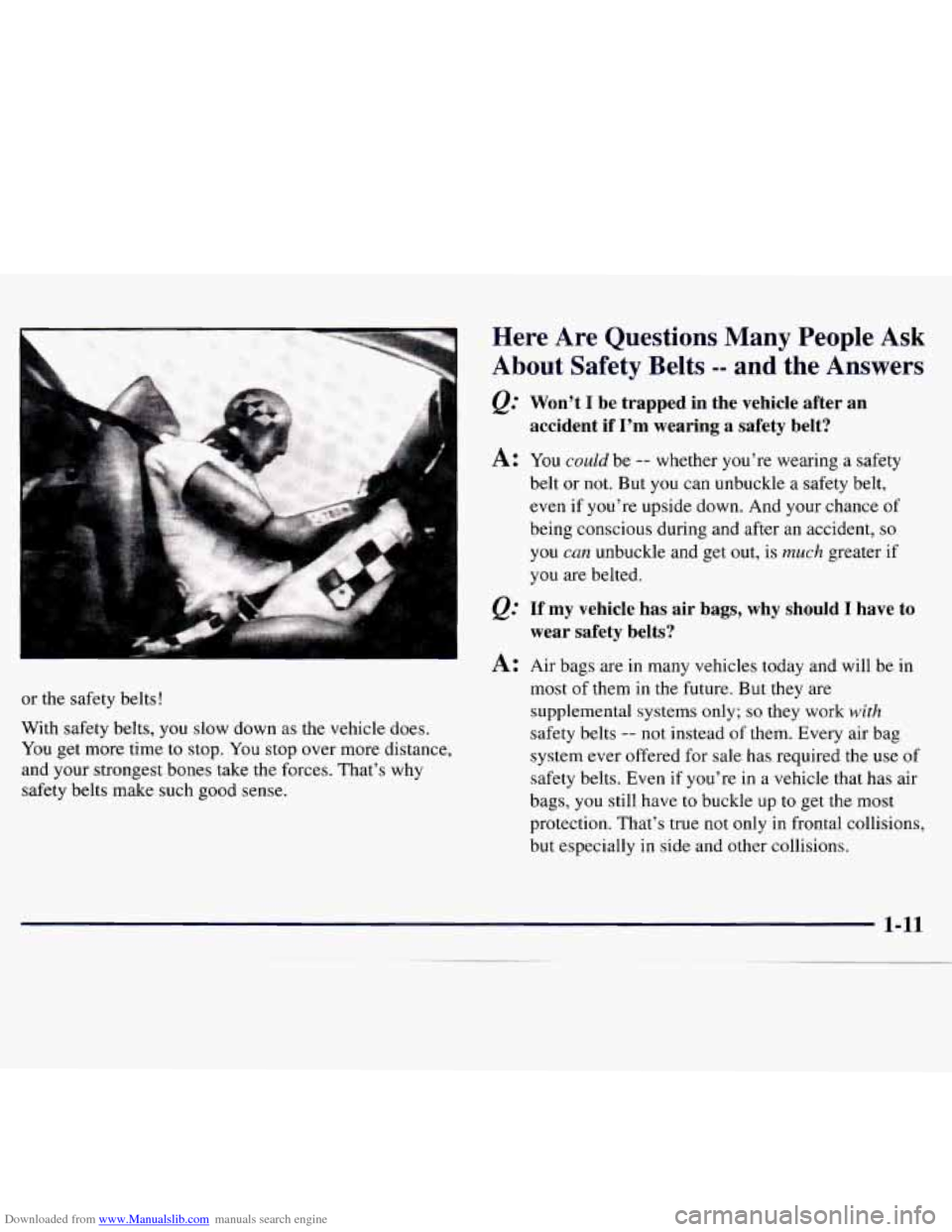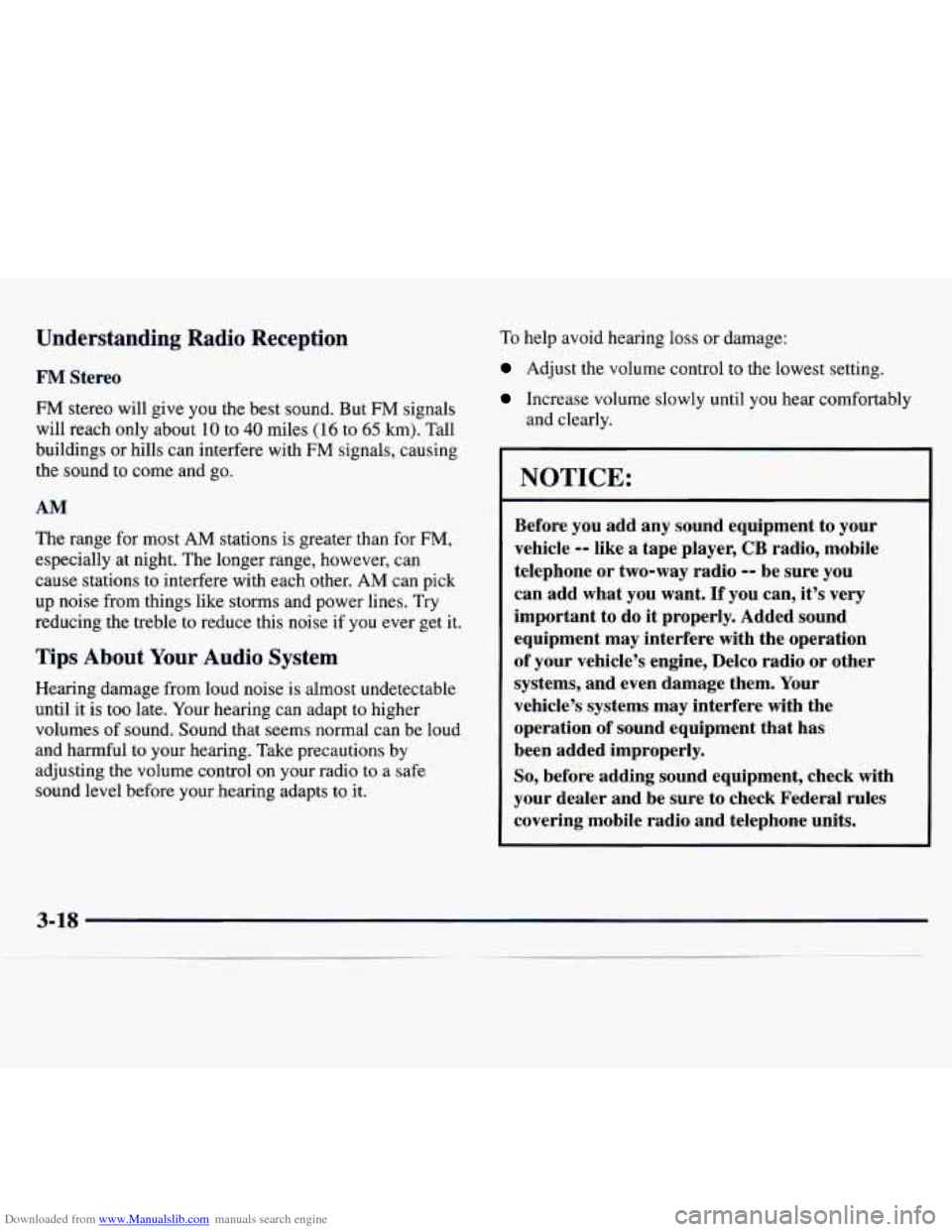1997 CHEVROLET MONTE CARLO ESP
[x] Cancel search: ESPPage 10 of 358

Downloaded from www.Manualslib.com manuals search engine Supplement to the 1997 Chevrolet Lumina and Monte Carlo Owner’s Manuals
This is a correction to information found on page 2-34 and 2-35 (Lumina) and page 2-34 (Monte Carlo).
Daytime Running Lamps / Automatic
Headlamp Control
Daytime Running Lamps (DRL) can make it easier
for others to
see the front of your vehicle during the
day. DRL can be helpful in
many different dnving
conditions, but they can be especially helpful in the
short periods after dawn and before sunset.
A light sensor on top of the instrument panel makes
the DRL work,
so be sure it isn’t covered.
The DRL system will make your high-beam headlamps
come on at a reduced brightness when:
The ignition is on,
The headlamp switch is off and
The parking brake is released.
97LUMWCARL0001 When
the DRL
are on, only your reduced intensity
high-beam headlamps will be on. The taillamps,
sidemarker and other lamps won’t be on. Your
instrument panel won’t be
lit up either.
When it’s dark enough outside, your DRL will turn off
and your low-beam headlamps will turn on. The other
lamps that come on with your headlamps will also
come on.
When it’s bright enough outside, the low-beam
headlamps will go out and DRL turns on your
high-beam headlamps at reduced intensity.
To idle your vehicle with the DRL off, set the parking
brake while the ignition is in
OFF or LOCK. Then start
your vehicle. The DRL will stay off until you release
the parking brake.
As with any vehicle, you should turn on the regular
headlamp system when you need it.
1
Page 24 of 358

Downloaded from www.Manualslib.com manuals search engine or the safety belts!
With safety belts, you slow down as the vehicle does.
You get more time to stop.
You stop over more distance,
and your strongest bones take the forces. That’s why
safety belts make such good sense.
Here Are Questions Many People Ask
About Safety Belts -- and the Answers
&: Won’t I be trapped in the vehicle after an
accident if I’m wearing a safety belt?
A: You could be -- whether you’re wearing a safety
belt or not. But
you can unbuckle a safety belt,
even if you’re upside down. And your chance of
being conscious during and after an accident,
so
you can unbuckle and get out, is much greater if
you are belted.
&: If my vehicle has air bags, why should I have to
A: Air bags are in many vehicles today and will be in
most of them in the future. But they are
supplemental systems only;
so they work with
safety belts -- not instead of them. Every air bag
system ever offered for sale has required the
use of
safety belts. Even
if you’re in a vehicle that has air
bags,
you still have to buckle up to get the most
protection. That’s true not only
in frontal collisions,
but especially
in side and other collisions.
wear safety belts?
Page 63 of 358

Downloaded from www.Manualslib.com manuals search engine Door Locks
-
Unlocked doors can be dangerous.
Passengers
-- especially children -- can easily
open the doors and fall out. When a door is
locked, the inside handle won’t open it.
Outsiders can easily enter through an unlocked
door when you slow down or stop your vehicle.
This may not be
so obvious: You increase the
chance
of being thrown out of the vehicle in a
crash if the doors aren’t locked. Wear safety belts
properly, lock your doors, and you will be far
better
off whenever you drive your vehicle.
’
There are several ways to lock and unlock your vehicle.
From the outside, use your door key or remote keyless
entry transmitter if your vehicle has
this option. From the inside, push the lever to lock the
door
manually.
To unlock, pull the lever.
Power Door Locks
Press the power door lock switch to lock or unlock
both doors.
Page 67 of 358

Downloaded from www.Manualslib.com manuals search engine Synchronization
Synchronization may be necessary due to the
security method used by this remote keyless entry
system. The transmitter does not send the same signal
twice to the receiver. The receiver will not respond to
a signal it has previously been sent; this prevents
someone from recording and playing back the signal
from the transmitter.
To resynchronize the transmitter with the receiver, do
the following: While standing close to your vehicle,
simultaneously press and hold the
LOCK and UNLOCK
buttons on the transmitter for about five seconds. The
door locks should cycle (lock and unlock) to confirm
synchronization. If the locks
do not cycle, see your
dealer for service.
Trunk
-
It can be dangerous to drive with the trunk lid
open because carbon monoxide (CO) gas can
come into your vehicle. You can’t see or smell
CO. It can cause unconsciousness and even death.
If you must drive with the trunk lid open or if
electrical wiring or other cable connections must
pass through the seal between the body and the
trunk lid:
Make sure all windows are shut.
nrn the fan on your heating or cooling
system to its highest speed with the setting
on
VENT. That will force outside air into
your vehicle. See “Comfort Controls’’ in
the Index.
instrument panel, open them all the way.
If you have air outlets on or under the
See “Engine Exhaust” in the Index.
Page 68 of 358

Downloaded from www.Manualslib.com manuals search engine Trunk Lock
To unlock the trunk from
the outside, insert the door
key and turn it. You can
also use the remote keyless
entry function if your
vehicle has this option.
Just press the trunk symbol
on the transmitter, making
sure your shift lever is in
PARK
(P).
Remote Trunk Release (Option)
Press the button under the
instrument panel on the
driver’s side. Your transaxle
shift lever must be in
PARK (P).
Remember, your trunk can be opened at any time using
this lock release,
so be sure to lock your doors.
Theft
Vehicle theft is big business, especially in some
cities. Although your Chevrolet has
a number of
theft-deterrent features, we know that nothing we put
on it can make
it impossible to steal. However, there are
ways you can help.
Key in the Ignition
If you leave your vehicle with the keys inside, it’s an
easy target for joy riders or professional thieves
-- so
don’t do it.
When ydu @ark your Chevrolet and open the driver’s
door, you’ll hear a chime reminding you to remove your
key from the ignition and take it with you. Always
do
this. Your steering wheel will be locked, and so will
your ignition and transaxle. And remember
to lock
the doors.
Page 93 of 358

Downloaded from www.Manualslib.com manuals search engine Daytime Running LampdAutomatic Headlamp Control
Daytime Running Lamps (DRL) can make it easier for
others to see the front of your vehicle during the day.
DRL can be helpful in many different driving
conditions, but they can be especially helpful
in the
short periods after dawn and before sunset.
A light sensor on top of the instrument panel makes the
DRL work,
so be sure it isn’t covered.
The
DRL system will make your low-beam headlamps
come on at a reduced brightness when:
The ignition is on,
The headlamp switch is off and
0 The parking brake is released. When the
DRL are on, only your low-beam
headlamps will be on. The taillamps, sidemarker and
other lamps won’t be on. Your instrument panel won’t
be lit up either.
When it’s dark enough outside, your low-beam
headlamps will change to full brightness. The other
lamps that come on with your headlamps will also
come
on.
When it’s bright enough outside, the regular lamps will
go out, and your low-beam headlamps change to the
reduced brightness of DRL.
To idle your vehicle with the DRL off, set the parking
brake while the ignition
is in OFF or LOCK. Then start
your vehicle. The DRL will stay off until you release the
parking brake.
As with any vehicle, you should turn on the regular
headlamp system when you need it.
Page 137 of 358

Downloaded from www.Manualslib.com manuals search engine Understanding Radio Reception
FM Stereo
FM stereo will give you the best sound. But FM signals
will reach only about 10
to 40 miles (16 to 65 km). Tall
buildings or hills can interfere with FM signals, causing
the sound to come and go.
AM
The range for most AM stations is greater than for FM,
especially at night. The longer range, however, can
cause stations
to interfere with each other. AM can pick
up noise from things like storms and power lines. Try
reducing the treble to reduce this noise if you ever get it.
Tips About Your Audio System
Hearing damage from loud noise is almost undetectable
until
it is too late. Your hearing can adapt to higher
volumes of sound. Sound that seems normal can be loud
and harmful to your hearing. Take precautions by
adjusting the volume control on your radio
to a safe
sound level before your hearing adapts to
it.
To help avoid hearing loss or damage:
Adjust the volume control to the lowest setting.
Increase volume slowly until you hear comfortably
and clearly.
NOTICE:
Before you add any sound equipment to your
vehicle
-- like a tape player, CB radio, mobile
telephone or two-way radio
-- be sure you
can add what you want.
If you can, it’s very
important to do it properly. Added sound
equipment may interfere with the operation
of your vehicle’s engine, Delco radio
or other
systems, and even damage them. Your
vehicle’s systems may interfere with the
operation
of sound equipment that has
been added improperly.
So, before adding sound equipment, check with
your dealer and be sure to check Federal rules
covering mobile radio and telephone units.
Page 144 of 358

Downloaded from www.Manualslib.com manuals search engine The body takes about an hour to rid itself of the alcohol
in one drink. No amount of coffee or number of cold
showers will speed that up. “I’ll be careful” isn’t the
right answer. What if there’s an emergency, a need to
take sudden action, as when a child darts into the street?
A person with even a moderate BAC might not be able
to react quickly enough to avoid the collision.
There’s something else about drinking and driving that
many people don’t know. Medical research shows that
alcohol in a person’s system can make crash injuries
worse, especially injuries
to the brain, spinal cord or
heart. This means that when anyone who has been
drinking
-- driver or passenger -- is in a crash, that
person’s chance
of being killed or permanently disabled
is higher than
if the person had not been drinking.
I A CAUTION:
Drinking and then driving is . -ry dangerous.
Your reflexes, perceptions, attentiveness and
judgment can be affected
by even a small amount
of alcohol. You can have a serious
-- or even
fatal
-- collision if you drive after drinking.
Please don’t drink and drive or ride with
a driver
who has been drinking. Ride home in a cab; or
if
you’re with a group, designate a driver who will
not drink.